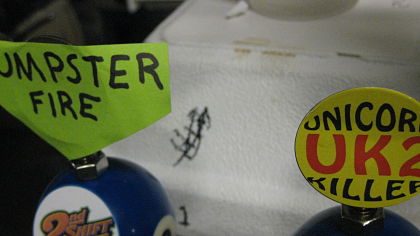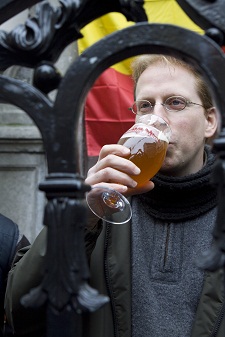Let’s cut directly to the press release.
The Weeping Radish, North Carolina’s oldest micro brewery, will debut its first beer produced from all locally grown hops and malt.
A year ago, the brewery began producing the first beer dry hopped with the first commercially available hops grown at Ecoview Farm in Weaverville, NC. Named IPA 25, in order to celebrate 25 years of micro brewing in NC, this beer has a unique fruitiness which comes from the young hops plants grown in the North Carolina mountains.
Now the Weeping Radish has expanded the local ingredient list of its annual Christmas Beer to include malt grown at Chris Hoffner’s dairy in Mount Ulla, NC. This would not have been possible without the groundbreaking work of Brent Manning and Brian Simpson, the founders of Riverbend Malt House in Asheville.
“We are proud to have received the malt with the ‘Invoice #1’ from Riverbend,” says Uli Bennewitz, owner of the Weeping Radish. “The 20 barrels of Christmas Beer are currently aging at the brewery’s cellar.”
This very special batch will be launched at the Carolina Farm Stewardship Conference in Durham on Nov. 12. “This is the most appropriate place to launch this beer” according to Uli. “This organization has been in the forefront of the sustainable farm movement for over 20 years, growing from obscurity to being one of the leading organizations in the country.”
“We did not limit ourselves to 20 barrels because we wanted to be coy, we had to because that was all the local malt which we could get at this time,” said Nick Williams, the brewer.
The trend towards a more “local” based economy is catching on all over the United States. From an explosive growth in farmers markets and local food systems, to “made in the USA” stickers on manufactured goods to a doubling of members of the N.C. Department of Agriculture and Consumer Service’s “Goodness Grows in NC” program. All of these signs point to the fact that consumers are seeing the value of local products.
The micro brewing industry has also received a boost by the fact that the two brew giants, controlling by far the largest share of the U.S. beer market, are now in foreign hands.
And the truly “non planned” twist of the story: Chris Hoffner, who grows the barley, also works with the Weeping Radish’s Master Butcher, who turns some of the beef from Hoffner’s dairy into delicious local hot dogs and beer brats. What a story: Christmas Beer and Beer Brats with ingredients from the same farm in North Carolina! The local movement has truly arrived!
Goodness, I’m all for local beer. I even own a related domain name, drinklocalbeer.com (don’t bother, you’ll just end up back here). I appreciate when a brewer allows his or her beer to express a bit of terroir. And part of the reason I started this blog was to rag on the importance of ingredients.
The Weeping Radish — now officially Weeping Radish Eco Farm & Brewery — had been around 25 years, so obviously is not in the gimmick business (my bullshit antenna start twitching when the word trend creeps into the conversation). A few more details about the ingredients, other than they are “local” would make that clear. For instance . . . I’m ornery enough to want to know all sorts of things about growing conditions and processing. But a good place to start would be a press release that includes descriptions of the varieties of barley and hops in the beer.

 Wendy Littlefield took a few seconds from her busy schedule getting ready for Tuesday’s
Wendy Littlefield took a few seconds from her busy schedule getting ready for Tuesday’s